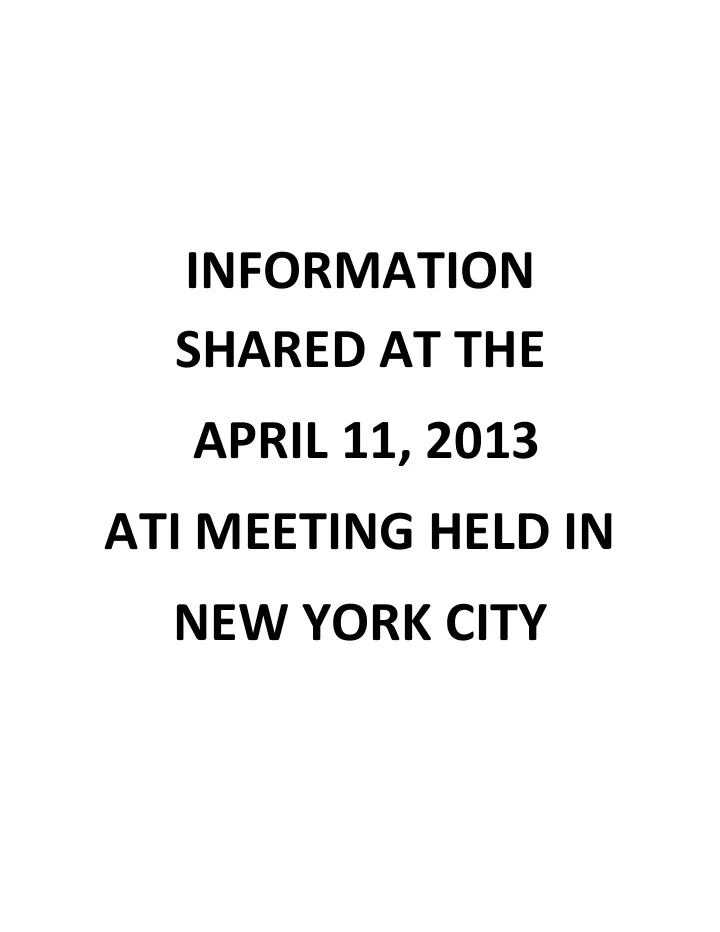

INFORMATION SHARED AT THE APRIL 11, 2013 ATI MEETING HELD IN NEW YORK CITY
04/12/2013 2012 Individuals in Jail & Prison n=81,953 Monroe, 4,298, 5% E i Erie, 3,991, 5% 3 991 5% NYC, 36,704, 45% Suffolk, 3,899, 5% Nassau, 3,097, 4% Onondaga, 2,973, 4% W Westchester, 2,931, t h t r 2 931 3% Other Non-NYC Albany, 2,440, 3% Counties, 20,013, Orange, 1,607, 2% 24% Note: Includes only counties comprising >2% of the Statewide confinement population. 49 counties are included in Other Non-NYC Counties. 1 2012 Reported Index Crime N=450,192 Monroe, 25,378 , 6% E i Erie, 31,472 , 7% 31 472 7% NYC, 195,753, Suffolk, 28,774 , 44% 6% Nassau, 19,467 , 4% Onondaga, 13,524 , 3% , Westchester, 14,925 , 3% Other Non-NYC Counties, 101,543 , Orange, 9,450 , 2% Albany, 9,906 , 2% 23% Note: Includes only counties comprising >2% of the Statewide reported index crime. 49 counties are included in Other Non-NYC Counties. 2 1
04/12/2013 ATI Funding Plan Will Maintain Infrastructure and Services • About two thirds of funding will be made g available pursuant to a reapplication process. • About one third of funding will be allocated pursuant to an RFP. p • SATSO programs – current contracts will be maintained. 3 Why Are We Doing This? 1) Improve Targeting Programming targeted to individuals at risk of Programming targeted to individuals at risk of detention or recidivism using risk and needs assessment. 2) Implement Quality Assurance Ensure funded programs operate with “fidelity.” 3) Implement Ongoing Evaluation Annual outcome studies of recidivism and other expected program results. 4) Refine and Improve Program Outcomes. 4 2
04/12/2013 Why Are We Doing This? 5) Additional Resources will allow services to be more aligned with high crime/high be more aligned with high crime/high confinement counties. 6) Higher Risk Populations Will Be Targeted. 7) NYS Can Further Reduce Crime and Confinement. 5 Even If Programs Are Effective for All, Prioritizing High Risk Will “Buy” More Public Safety If we are seeking to reduce recidivism by 10% for 1,000 offenders released from prison, we “buy” the most public safety if we target high risk offenders: f t if t t hi h i k ff d 1,000 High Risk: 69% - 6.9% = 62% Recidivism 69 recidivists avoided, 179 events avoided (High Risk Recidivists: 2.6 reconvictions/recidivist) 1,000 Moderate Risk: 43% - 4.3% = 39% Recidivism 43 43 recidivists avoided, 77 events avoided idi i id d 77 id d (Moderate Risk Recidivists: 1.8 reconvictions/recidivist) 1,000 Low Risk: 17% - 1.7% = 15% Recidivism 17 recidivists avoided, 25 events avoided (Low Risk Recidivists: 1.5 reconvictions/recidivist) 3
04/12/2013 Improve Outcomes through Improved Targeting and Service Delivery More Targeted g Services Current Level of Service Improved Delivery through Fidelity Persons Crimes Persons Crimes Served Served Avoided Avoided Served Served Avoided Avoided 1,500 139 1,500 214 Employment Programming 3,400 316 3,400 486 Alternatives to Incarceration 0 n/a 650 93 Additional/New Funding 7 Time to Reconviction, Felons Released from Prison 80% 69% 70% 63% 60% 54% 54% 50% 43% 41% 3 7% 40% 30% 30% 21% 19% 1 7% 20% 14% 10% 8% 10% 6 % 2 % 0% Year 1 Year 2 Year 3 Year 4 Year 5 High Risk Medium Risk Low Risk 8 4
04/12/2013 Time to Reconviction Felons: Jail and Probation Sentences 70% 60% 60% 56% 48% 48% 50% 50% 44% 40% 40% 35% 35% 34% 39% 28% 30% 27% 20% 18% 20% 16% 16% 12% 9% 14% 10% 9% 4% 0% Year 1 Year 2 Year 3 Year 4 Year 5 Jail Under 25 Jail 25 and Over Probation Under 25 Probation 25 and Over Reconviction Activity for Persons < 25 Sentenced to Jail 80% 69% 70% 65% 60% 58% 58% 60% 60% 56% 48% 47% 50% 40% 35% 28% 30% 20% 16% 10% 0% Year 1 Year 2 Year 3 Year 4 Year 5 Misdemeanants Felons 5
04/12/2013 All Funded Programs Will Be Subject To Fidelity Reviews • Formal fidelity reviews will occur after programs are up and running and periodically thereafter and running, and periodically thereafter. • Program will be phased in over time. • Assess whether programs were implemented as expected; identify areas that need improvement. • Coaching and technical assistance will be available to bring programs up to optimal performance level. b i i l f l l • Assessments will be conducted by an entity designated by DCJS, and funded directly by DCJS. 11 NYS Fidelity Model Will Seek To Accommodate Three Scenarios • “Brand-name” programs Examples: Thinking for Change and the Offender Examples: Thinking for Change and the Offender Workforce Development Specialist (OWDS) Partnership Training Program • General types of programs Includes drug courts, cognitive-behavioral therapy, other programming with demonstrated effectiveness • Homegrown programs that incorporate principles of effective practice 12 6
04/12/2013 DCJS Recidivism Studies A Key Component of the Evaluation System • In the past, recidivism analysis has been limited because client risk information was not available. risk information was not available. • A methodology will be established to account for risk and confirm that results are as expected. • Case specific data on admissions and discharges will need to be submitted to DCJS. • Results will take time: Program participants must be followed for a minimum of one year. 13 Summary of Business Model Analyze Population and Program Needs Recommend Programming Through Cost Benefit Analysis Analysis Implement Programming Verify Program Quality (Fidelity) Evaluate Program Outcomes E l P O Confirm Results are as Expected Use Results to Inform Future Funding Decisions 14 7
Recommend
More recommend